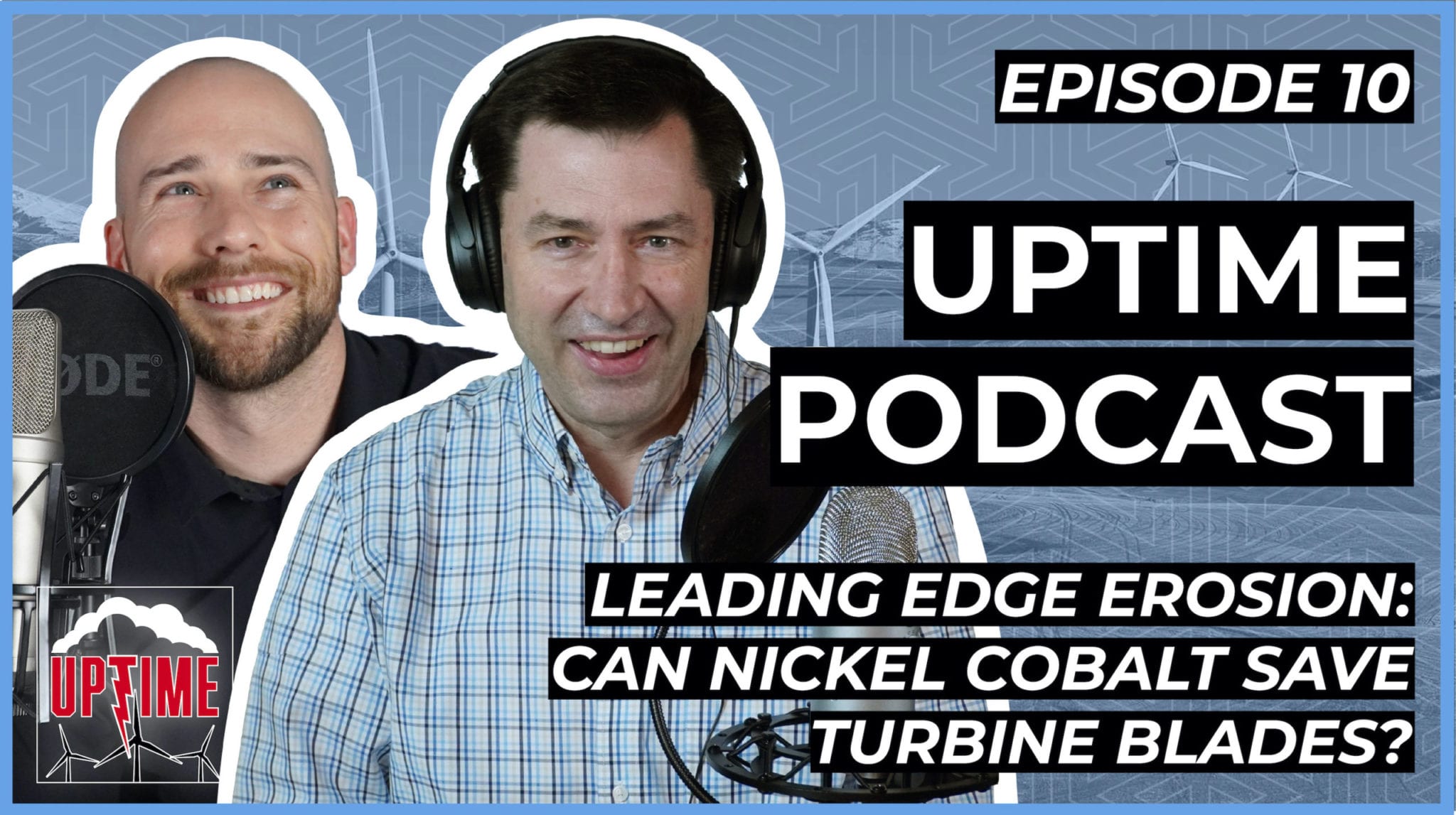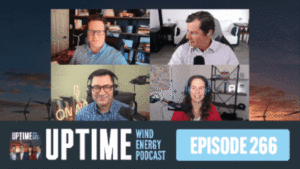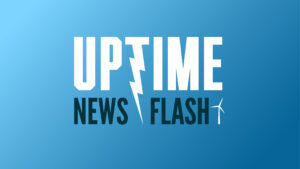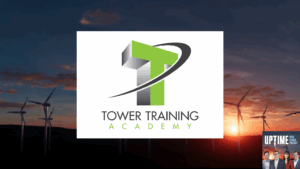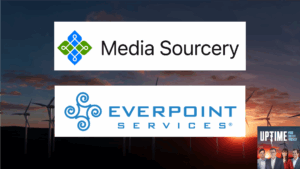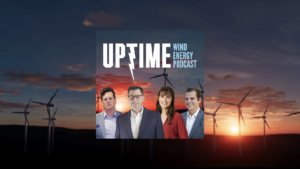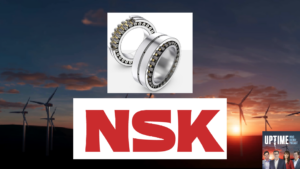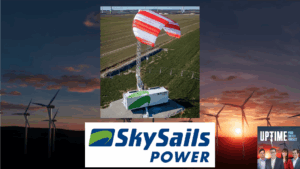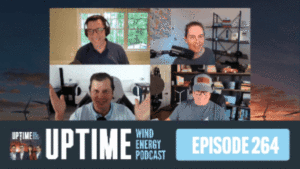In episode 10, Allen and Dan discuss new nickel cobalt wind turbine leading edge protection tiles that can be retrofitted onto blades to enhance their leading edge durability. Leading edge erosion of wind turbine blades is a huge, industry-wide problem that is yet to be solved…is this new application of airplane propeller technology able to fix it? Also discussed was HVDC (high voltage direct current) and it’s potential to replace HVAC (high voltage alternating current) as the top transmitter of power from offshore wind farms to the power grid.
Learn more about Weather Guard Lightning Tech’s StrikeTape Wind Turbine LPS retrofit. Follow the show on YouTube, Twitter, Linkedin and visit Weather Guard on the web. Have a question we can answer on the Uptime Wind Energy Podcast? Email us!
Read articles on nickel cobalt tiles here: https://www.windpowerengineering.com/new-research-brings-aerospace-blade-protection-to-the-wind-industry/ and here: https://www.tdworld.com/renewables/article/20972636/getting-offshore-wind-power-on-the-grid
Podcast: Play in new window | Download
EP10 – Nickel Cobalt Leading Edge Protection & HVDC Power: Full Episode Transcript
Check out our YouTube video version here: https://youtu.be/a8vHHqEmG98
At Weather Guard Lightning tech, we make wind turbine lightning protection easy.
If you’re a wind farm operator, stop settling for damaged turbine blades and constant downtime. Get your uptime back with our StrikeTape lightning protection system.
Welcome back. I’m Allen Hall. I’m Dan Blewett and this is the Uptime Podcast where we talk about wind energy engineering, lightning protection, and ways to keep your wind turbines running. Allen, episode 10 of the Uptime Podcast. How, how do you feel about this double digit. It’s exciting, isn’t it? Yeah. Two two digits. Yeah. We’ve made it. We’re big time now. We’ve got a long way to go get to get to three digits. That’s the problem. That’s a big gap. It’s, yeah, and then we get the four digits as it’s like we’ll both be dead. We’ll both be dead by that point. It’s exponential. A long time. Yeah. We need to get to where we can count it. Well, are we at a w? No, we don’t have any exponents yet. We’ve got to get some, have an exponent. Well, 10 to the second, 10 to the second, and we’re tend to the zero. Is that where it, no, 10 zero would be one 10 to the first. Wouldn’t tend to the zero B zero I liked under the zeros one. Hmm. I could be wrong. Isn’t major in math, so it’s fine. We’re good? Yeah, we’re good. So Corona virus week, like 97 Oh one minute recap. We’re starting to come out of a self isolation there. They’re opening up. Thinks this week, which means I think next we’ll kind of thing. It’s just like taco bell or taco bell. That’s the critical as the critical one. Whenever taco bell opens up where it’s like safe to slither out of our holes, let’s just, let’s just be, let’s let you be known that talk about never closed. They were over the whole time. Yes. Well, yeah, they’ve been there. They’ve always been essential in all of America’s hearts and stomachs. Yes. Thank you, taco bell for all you do of us staying open for us. Yes. But, uh, next week is, uh, all the barber shops and sorta that kind of nail salons and all of those things open up. So it’s sort of a big milestone, I think. Yeah. Which I think is fine. I mean, that’s fine. It’s a small, tiny, yeah. You have a couple couple people. No big deal. Right? Well, maybe it’s a big deal, but you have to be seen, I guess so. I’m just wondering how they’re going to work at all. It sounds like it’s one person at a time into the place and that’s all fine, right? Yeah. I mean, the logistics of a lot of it, just like the empty seats, it just throws in the question like in an airplane. Okay, all every other seats empty. How does that affect, I mean, it just like, it’s. All these metrics of how they build the business out and how many seats they have to sell to be profitable. It was just like thrown to chaos. It’s same thing for all the sports venues. I don’t know how they’re going to deal with this. The amount of money that baseball is losing in any particular game, it’s like 600 grand a game. Well, and the baseball thing makes, it just makes. I’m just like, no sense. I mean, I get that they’re just like making a proposal is to like make a proposal. Yeah. But the dugouts not 180 feet long. You can’t have six foot feet between every player in the dugout. And I guess they realize that they’re going to have the guys like in alternating rows in the stands or behind the dugout. Oh really? And it’s just like, that’s what I heard, because I’m sure they realize that like you can only fit 10 people in a dugout spaced out like that, you know? Maybe not. So, but it’s just like, there just seems like no realistic way that if you’re pitching coach. Has covert 19 that everyone doesn’t get it from. Like, Hey, how? How can like one, and that seems to be the purpose of these things. It’s like if a person has it. We want to make sure no one else gets it, but how can your manager have it and then the rest of you not get it. How can your first basement have it and the rest of you not get it? Just like makes no sense. If the trainer has, there’s no way everybody has it. There’s no, there’s no way. No way. There’s just no way. But they can’t just, they can’t just say that and be like, Oh, Hey, look, we’re all gonna get it. So it’s fine. We’re not going to have a plan. Like obviously they can’t do that, so I get it. But Walmart, Walmart has a plan. I think the NBA and MLB and NFL can have a plan. That’s reasonable. Reasonable. Well, you sent me that, uh, that ebook the other day talking about the checklist and I’ve been listening to that diligently cause it’s got like 800 chapters by the way. And really? Yeah, I thought it was a kind of short, I mean like it only took me like, what is like a six hour. Uh, well, it wasn’t that long. I don’t think, maybe eight at most. I try to, I try and get to get one chapter at a time, but what they’re talking about is when they had the floods down in new Orleans and how, uh, large organizations had trouble, but Walmart just said, screw it. We’re gonna, we’re gonna just do the best we can and we’re gonna let everybody just make decisions on the fly and see what they could do. Not, not a bad way to go about it. That was an interesting, yeah, that was an interesting section. So the book we’re referencing is the checklist manifesto by Atul. Gawande, I believe is the doctor’s name. And, uh, he wrote this book. Just, uh, from his research in how important checklists are to just reducing the casual mishaps that cost hospitals lives, and tons and tons of money just by forgetting to, like, one of the examples was, um, in treating line infections. So when you have Ivy lines. Like they essentially reduce line infections. You know, like, you know, you get an infection in the site of where they put the IV in from, like, you know, seven, eight, 10% is effectively zero. Just by saying, every time you put in a line, you’re going to do these five things like dressings on this part of the body. You’re going to wash the skin here. You like go through every one of these five things and it just had miraculous effects. And they had a lot of really interesting stories. I mean, with the aviation industry, which makes total sense. But not just like, Oh, here’s 87 checks. Do you have to do? Right. It was like they said the aviation ones were very simple because they knew the pilots. Like, we’re going to memorize a lot of it, but not all of it. Right. Has that been your experience in the industry? It is. It’s when we got into, my wife and I are both engineers. So when we got into engineering, real engineering world, that’s one of the first things you realize. Uh, cause we worked in space and in space. Everything’s a checklist. So as you come out of school, the first thing you realized, like everything has a checklist and you’re not going anywhere without having a checklist that someone else has looked at. And then you’re going to check off the checklist and then someone’s going to sign off that you check the checklist and then it’s going to go into a file and someone’s gonna make sure that the checklist has been filled out just so you don’t make mistakes. Yeah, it does. The chimpanzee have his helmet. Does he have his lunch box? Does he have, you know, all this stuff to send this little monkey in space? Yes. He needs all of his things. It kind of works. It works just like that because otherwise you just lose track. And even, you know, anything in an industry, you see a lot more of it. Now, when I first got to the aircraft business, and in, even in the winter, we’re in, turbines can be just as bad. Uh, when I first got to those two industries, it was amazing how little checklist things that there were, but they’ve gradually. They’ve acclimated to the, the realization that having some sort of checkoff reduces errors. Yeah. Yeah. It does. You know, we forget stuff where we just haphazardly do stuff and we forget. Yeah. So on, I think it was a good book, just as a refresher to like, say, okay, where do I maybe need to integrate these more into my life? As I complete projects, making sure I didn’t miss school. It’s easy to miss. Just little things. It was just everyone does it. So that’s right. So, speaking of, uh, speaking of checklists on our to do list today, leading edge erosion. So there’s some new tech that we’re gonna talk about and then, uh, alternating current versus, um, high voltage, direct current and transporting power from winter binds to the grid. So let’s start with leading edge erosion. So a new article. Off the web today or not? Not today, but this week about nickel cobalt tiles. So this technology has been around for a little while, but they’re just now trying to apply this to wind turbines. Right, right. It’s something we’ve used on airplanes for a long time or something very similar. Anytime you have any rotating device or any time you’re going to be impacting a lot of ice, mostly ice crystals or water particles on a structure that you care about. On a propeller wing, uh, on an airplane, they’re going to use some, some something pretty robust, particularly propellors. So propellers, most propellers have a, uh, a nickel leading edge. And helicopter blades tend to be something very similar. Propellers not as robust as helicopters that way, but propellers have this Nichole leading edge. And what it’s there for is to stop erosion of the, of the blade, and it looks like. Or E catapult, which is offshore renewable energy catapult, which is based in the United Kingdom, has been doing some rain erosion testing, comparisons of different kinds of rain erosion methodologies, techniques, materials, the whole thing. Uh, because they have a lot of wind turbines off shore. Obviously, and, uh, they’re trying to find a good solution. So they’ve been publishing some papers recently on nickel, cobalt and willing to kinda, it looks like Dan, didn’t you think it was, it looked like shingles in a sense of like these little sections that are kind of glued onto the blade? Yeah, it looks like them and they call, they refer to them as tiles, so it seems to be that way. Yeah. So it’s a bunch of tiles that get kind of glued on. And I’m sure that they’ve done a lot of testing. So the testing indicated they had done 85 hours in a rain erosion test facility at a higher speed, and it did well versus, uh, like, you know, 15 hours at a lower speed. So they said that there’s definitely some erosion benefit. Yeah. Well, the faster you go, right. It’s one half. I’m going to throw you, I’m going to throw you an energy equation. One half mass velocity squared. So as you go up and velocity, it actually squares the energy. So going up a couple of miles an hour actually does a lot more damage. So you double the velocity, you quadruple the energy of each impact that adds up. So it doesn’t take long to really increase the energy. So going to a higher speed obviously is a lot more conservative. So why that that specific material? Like you don’t hear about nickel. At least in the consumer market, obviously, like the commercial market you hear, I’m sure there’s a lot of different technologies, but in the, in the consumer market year of things made a copper and when they need to be durable and resist anything, a stainless steel, like what? What’s the deal with nickel? Cobalt? It’s hard. It’s really, really hard. Uh, that’s, and it doesn’t, it takes a lot of abuse before it starts to give away. It’s just a really hard, durable material. And what I mean hard, it’s got pluses and minuses when you deal with hard materials. It’s hard. It’s very difficult to form them into any particular shape. Ductile, ductile fertility. Yeah. They’re high risk middle school. Yeah. So there are, there are high resistance material electrically. Uh, that can be kind of on the brittle scale. More towards brittle than flexible, like copper’s very pliable. Uh, Nicole doesn’t tend to be that way, but that’s why they coat things in Nicole, a lot of times, uh, on aircraft parts, the things that are outside, like, uh, around the landing gear and that kind of thing, they can get nickel plating plating on it because it’s a very hard material. Yes. They form it with a more malleable material and then just played it with nickel. Right. Yeah. That makes sense. Yep. Yep. So that’s the same kind of thought here. Now, the cobalt part of the nickel cobalt I thought was interesting because I thought we were trying to get away from using cobalt so much. A little. Yeah. It’s a little controversial. People are getting killed over it. It’s still a conflict mineral, right? Yeah. It is in some places, so that’s why they’re trying to get rid of it and batteries. Yeah. It’s got a great color though. Cobalt, just a super blue bluish color, right? Yeah. I guess it’s cobalt blue is a cool color, but. That’s a really good call. Is it worth dying over? Not worth dying over, but it’s a great color for an element. Yeah. Um, so they use these usually on airplane propellers. So why has it been, why has it taken so long for them to put something metallic on the edge of a wind turbine blade? I mean, wind turbines have been around for 20 plus years. Why is, why is this a new idea now? I don’t know if necessarily it’s a new idea. It’s more of. How desperate do you have to be before, before you get to some solution like that, because you want to try everything else. You’re trying to, you’re trying to do it less in Alexis, expensive, more manufacturing friendly design than nickel cobalt would be. So putting on tiles is, I’m sure it’s going to be labor intensive and I’m sure it’s going to be expensive and I’m sure it’s going to run into problems, uh, versus just. Spraying on are more durable coating that those are your two choices. You’re going to go to spray on coating versus gluing things, something on that. That’s, that’s, that’s what’s happened. And so until, until the sprout coatings show that they don’t last as long as in theory as they are. We’re predicted to last. You don’t get to the next stage. It’s just like anything else, right? You, you try it, you see what it works. If it doesn’t work well enough, then you go to something that’s more extreme. Let’s back up. So, so what is, what is the typical leading edge, um, compose of also off the factory floor? Uh, it depends on whose main manufacturing it was. Just talk very generic and simple terms. It’s basically just as long. It’s this, it’s basically the same kind of coding that to make the blade out of, it’s going to be. Some sort of resonance system with, uh, uh, with a painted coding on it. Sometimes they’ll add a, another. Pliable coding to it. The ones you see out in the repair world where they’ve gone out and repaired Glades and the leading edge of blades, it’s, it tends to be glad to have a coding that they’ve rolled on with a roller. So it’s just another sort of thickened paint or polyurethane ish kind of thing. I’ve, I in, I think, uh, was it Polytech and or Siemens Gamesa we’re doing something similar last summer where they were putting on this, basically it’s Paula urethane erosion. Materials is kind of a real thick plastic, rubbery plastic. It’s used on airplanes all the time, and they were applying it to the winter events just to absorb the rain blows. Yeah. That, that’s, that’s, you know, from that, just the, the simplest forms. That’s kind of what you see. Either some sort of spray on rub on coating or polyurethane sheet that’s applied to the leading edge. Yeah. Simple. So, so is putting metal on the edge of these turn lays that going to be a lightening nightmare or what? Yeah. So just just sum it up and just nightmares. It’s a going to be fun. You got two problems, you’ve got static charge buildup, and then you have the lightening issue. So it’s a piece of metal hanging on a blade. Yeah, it’s gonna attract lightening and how are you going to ground all these tiles? I don’t know. You’re gonna have to figure out some way to do that. It isn’t like you can connect to Nicole very easily. That’s one of the problems with Nicole’s that nothing really sticks to it. That’s why you use it. So because things don’t stick to it. What do you mean? What do you mean stick adhesive adhesive or solder or bolt things up to it? It’s just not a material. It’s kind of like gold that way. Like it’s some metal that doesn’t like to bond anything else without going to extreme efforts. Um, so that, that’s, that’s the problem. And then each of these, if you, if you, if you think of them as individual tiles, you got these electrically isolated pieces of metal. Impacting rain, ice, and rain all the time. They’re going to build up charge and they’re gonna start sparking those. You can. There’s only so much charge, I think a whole before it’ll start to spark over and try to find a ground path somewhere. So they got to figure out that problem too. So it may have figured out the erosion problem. It’s the same thing. We had that same problem on airplane propellers for years. You know, you put this leading edge on. And it stopped all the mechanical erosion. And the problem is you start blowing up the static charge and the Pella blade sparking over everything. It’s parked parking over everywhere, making all kinds of electrical noise, which you don’t want, and create these big discharges to places you don’t want. They’re going to have the same problem. That doesn’t sound, that doesn’t sound great. Yeah. No. So do you, I mean, is there an opportunity here? So are you got this, you know, long strip of cobalt tiles on the edge. Can you then link that to something like a segment, a lightening diverter, like strike tape. Can you like integrate this in like does this have to suddenly, I assume it probably has to become part of the entire lightning round ECOS ecosystem, right? Yeah, it would. How are they going to connect it? I don’t know. Having dealt with that on an aircraft for a number of years, it’s no fun. Making connections to those leading edges is no fun. A lot of times. On a propeller. It’s very sacrificial. If you, if the propeller were to take a strike on an aircraft, it’s just got to survive long enough to get you back on the ground, cause you’re gonna take the propeller off and put a new one on. You really can’t do that on the wind turbine side. So you want to be able to take strikes on these tiles and not have to go replace them all the time. Because the reason you’re putting those tiles on is most likely is because the wind turbines out in the ocean somewhere and you don’t want to go out to the ocean, fix it. You want to put these tiles on the leave it, but it’s not just. Rain erosion you have to deal with. It’s everything else that goes along with it. You’re in an extreme environment. Lightning is one of those things. Static electricity is another one of those issues you’re going to have to find a solution for, and this is where all the compromises come in, and that’s where engineers have to make really hard decisions. Hey, look, we’re going to have to live with this negative impact to get this positive. Outcome. That’s where the, you know, the, the staplers start flying into conference rooms just because everybody has their opinion. I think there’s going to have to be some sort of compromise here and they better start looking at the lightning protection side of it. I’m sure somebody thought of it. It’s questioned what they’ve done about it. Yeah. I mean, are there other materials that are, I mean, like you think of ceramics that are. Less conductive, obviously, like they a candidate at this for this, I mean, I think there’s ceramic coatings and all sorts of stuff that you kind of get into hardness, brittle versus flexible to soft plus the fact that you’re rotating so fast. The problem with the polyurethane sheets that you. Bond onto winter and blades. As the speeds go up, there’s an, there’s a force trying to rip that sheet off the blade. I just go faster and faster and faster. You think about the G force, sort of the G forces associated with that. It starts to peel things off. There’s all kinds of problems that you have to think about here. I don’t know. I don’t know. We’ll see how it plays out. I one of the, when I read the articles like, Oh, this is cool. Then I read the article a little more like, Oh yeah, it just sounds like it could be problematic there. Just like you said, it opens up another can of worms that then has to be sort of solved for. Yeah. There is no perfect solution to any of this. You’re going to have to suffer somewhere. You’ve got to, got to, got to figure out where you are. You may, you may be able to live with a little bit of leading edge erosion to fix the lightening issue. Maybe. What other materials could you use there. Uh, you, there’s not a lot more to support. Is tortoise shell go natural? We’ve got to go natural. Renewable turtles are renewable resource. We just developed a huge turtle farm to get enough shells. Um, and then what am I saying? I love turtles. I don’t want to do that. But if we had synthetic turtle shells, then we could put them on. The, the blades. So you need someone an outside the box to solve these problems. You guys are too close. You’re too close to the issue. Um, well how, how thick do these tiles have to be to not just like melt cause they’re getting, I mean the current’s going to go in and through them. They’re not going to make like that ins channel, like a segment of lightning diverter. So how, how thick do they have to be to not. Pretty thick, decimated, pretty thick. So the nickel cobalt has a pretty high melting temperature, but it also gets hot really fast because it’s pretty resistive. So if you shove 200,000 amps into a tile, it’s going to get hot fast. Now, some part of it’s going to go past this melting temperature. Probably. You’re probably going to melt a hole in it. That’s most likely what’s going to happen. The other part about when you get something that hot. Uh, in a tile form, is that locally where it gets hot, it wants to expand so it wants to pull itself away, push those mega gap and then, yeah, it wants to bubble, I think of it, think of it like bubbling up. It’s sorta like that it wants to bubble up and swell up and get in. Because it’s so hot and you’re talking about more than a thousand degrees Celsius. More than likely it’s going to get really hot and all the structure underneath, it’s going to get really hot, which is another problem because you don’t want to damage the winter of instruction or neath of it, but you’re probably going to do that because if you stick on this piece of high resistance metal and you shove 200,000 amps into it. Whatever’s underneath, what’s going to get really hot really fast. Um, again, you know, this is, this is that engineering trade off. When I say staplers, flying across the room, I, I literally need staples because everybody has gets so wrapped up in their own particular solution that they’re willing to, to go to. Physical battle to defend it. It’s, it’s a weird engineering thing because everybody, well, cause they’re all working so dang hard on this thing, you know? And then someone could just come in, throw on you, throw on your colander and you’ve got like your spoon as your slide across in a, in a desk chair and you’re like, sting with whatever you can find. It sounds awesome. Uh, engineering meetings can be very contentious that way. And because. It’s everybody’s that when you get to a situation like this, everybody’s at full stress mode, typically because you’re trying to fix a problem that is big and it has a lot of visibility. And there is, there’s one part you can be credited for the win. You know, like, Hey, we come up with a solution that solved the world’s problems. That’s cool. So you want to defend that or the other hand, the closer you get to solving the world’s problem as the most vulnerable you are because of so many more people poking at you about it. So you have to be able to just kind of ignore the noise, but also make sure you’ve done your homework and, and take those, the hard part about all this. Because it happens in airplanes all the time, is to swallow your pride, listen to whatever everybody’s saying, and try to incorporate their ideas into this concept because it’s just like I was having this discussion about Thomas Edison and the light bulb. So Thomas Edison didn’t invite and just invent the light bulb by himself. Can we all get over that? Uh, I know a simplifies history quite a bit, but there’s really very few inventions that are made by themselves or in a vacuum. Uh. There. It’s usually done by some sort of group or, or a consortium of different people going after the same goal. And that’s how we find ultimately a good solution. And that’s going to exist here. It just takes it just going to take time to settle it out. So even though you’re just going to see a lot of articles and stuff popping out about. A way. They’ve theory solved a problem. You know, this is the time where they’re going to get poked back and we’ll see how they respond to it. Yeah. Well, you wonder if it a, it becomes a candidate for. Something like, you know, Elon Musk where he is released a lot of his patents just so that the car industry, electric car industry grows. Everyone can, everyone can grow, right? You wonder if it ends up being something like that. It could for all the, all the cookie things and counterproductive things he seems to do in the media. Um, and he does have obviously a lot of good ideas. That seems like one of them to push his industry farther off was throw Elon Musk into the Thomas Edison bucket. Elon Musk isn’t coming up with all those ideas like, come on. Right? He’s got a bunch of smart people that surround him too. They focus energy on him. He, he, he’s the one that’s willing to take the blows in the media, uh, to keep this other engineers and scientists away from the controversy. He’s now coming to all of these things. Yeah. That’s fair. So let’s shift gears. So the other sort of longterm problem solution is getting. Uh, the energy collected by wind turbines into the power grid. So still today it’s alternating. Current is the way pretty much all of them send their power. But now there, there’s more, uh. Press releases and articles about the potential to switch over to director. So you as an electrical guy, how do, uh, how do you, how do you find that? How does that sit with you? So you, you go to engineering, specifically electrical engineering school, and the first thing they tell you is, Hey, in order to transmit a lot of power, you need to cut down the amount of current. Because you’re going to shove it through a wire, a wires resistive. So the power loss and the wires are related to how much current you’re shoving through it. So it’s ice squared. Ours is the current runs to the wire. That’s amounts powers dropped in. The wire is resistance of the wire times occurrence squared. There it is. There it is. Uh, the, the problem is, and the way you solve that issue, raise the voltage up really, really high. So if you raise the voltage up really, really high, you drop the current really low. There’s less power dropped in the wire. Okay. That’s what you’re taught in electric engineering school, the problem. And so the problem with doing a DC wise is you can’t really get from, I don’t pick a big volt, 12 volts. You can’t get from 12 volts to like no 13 volts volts, 30 volts to 32,000 volts, roughly. It’s hard to get there without having some sort of electronic device to lift the voltage up that high so he can transmit it. That’s, that’s a trouble. So what, uh. W w because you can, you can transform AC voltages and currents easily. What the transformer. That’s what Tesla invented, way back with Westinghouse, way back when. Uh, it’s hard to transform DC in anything because it takes electronic, essentially it takes electronics. And so until recently, in the last couple of years, we haven’t be able to get to really high voltage enough where he could. Shove energy very far, but there may be an advantage to trans meeting some energy via DC, particularly with shorter ranges. Probably it’s where they’re going. Um, it may take less copper to do it, but it also may have an advantage of making the cable itself less expensive depending on how they set up the, the, one of the issues with the, with, with, uh, alternating current. Because it’s alternating. You get this sort of, uh, these magnetic fields that are set up and you’re, you’re creating and destroying these magnetic fields all the time. So you have this quote unquote reactive power thing going on. So you’re like, there’s some losses in reactive power that you don’t necessarily have in DC. Uh, that’s sort of the trade off. So if you’re really trying to get super, super, super efficient on transmitting. Power from a to B, it may be easier to do with high voltage DC. If you can get the electronics and the electronics are reliable enough to do it, that may be the best, most efficient way to do it. Hmm. Okay. So as these get farther and farther off shore, you know, into the hundred kilometers off shore kind of range, you still think it’s AC or DC probably that far out. You’re thinking electronics work is going to be DC if they can make electronics work. That’s going to be, think about any time you throw another piece of electronic equipment in the middle of something, you really need a putting a coil, a copper wire, and in a bucket of oil, which is essentially what a transformer is, doesn’t have any moving parts. There’s no electronics. Those transistors evolve at that process. As soon as you shove something electronic into this pathway, you have faults and failure modes that you just. Really don’t have with high voltage transformers. So on the, on the, on the HV DC trail, tell me real quick how it gets from wind turbine into, into my home to power this microphone. Like where does it go? Like what is it? People talk about a power grid. I’m like, just tell me the journey of this electric electricity to get to the power grid to get here. So it depends how the generator set up, but without getting into too much depth in how general, how power is generated at some point at the wind turbine. Um, it’s going to get converted to S typically it’s going to converted. It’s in some sort of AC form, and there’s transformers that raise the voltage jobs so you can transmit it down the line to a GitHub substation. And there’s some, there’s capacitors you have to put on the line. There’s, there’s a bunch of reactive capacitance issues you’re trying to deal with to get everything into phase or you’re trying to, one of the things you don’t want to do is connect up to the grid. AC power wise and be out of phase. It costs a lot of problems in the power company will dump you off the circuit when they, when they sense that happening. So from the wind turbine companies. Perspective, you want to be in sync with the power company. So why you got all these wind turbines that are all generating power. They’re coming to some sort of substation and then they’re connecting, sinking up with the substation, and once the power company thinks you’re cool and everything is right, they’re going to hook you up to the grid and you’ll be part of the grid. And if you ever get off that, they just dump you. Which is a problem. So what they’re talking about now, as you’re sort of converting to DC, DC at the sort of closet of the base of the wind turbine, you’re transmitting down to down to somewhere near the substation. You converting that from DC to AC there, you’re sinking up right there. It gets rid of a lot of, uh, line issues, uh, capacitance issues. You have to deal with reactive issues you have to deal with as far as transmission line stuff. That’s what they’re talking about. So once you get to the grid, then you’re pulling off you. Dan is pulling off the grid. You never see all the stuff that’s happening behind the scenes back here. Uh, that’s, that’s invisible to you because you’ve got this cascade of, uh, power companies and engineers and technicians making sure that your lights don’t flicker. That’s how they’re doing it is they’re constantly monitoring that grid. So, um, it’s one of the issues for wind turbines and solar. It’s the same way, which is you gotta make sure you’re delivering the quality product. It’d be like at a gas station, right? So I have a tank full of gasoline. I can’t, I can’t have the wrong octane or the wrong mixture. And in a tank where it has the right mixture in it, it’s the same sort of thing. Like I want to make sure I’m delivering the right product the right time, so my customer’s happy.



